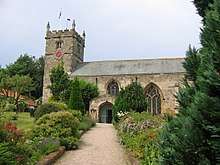Hunmanby
| Hunmanby | |
|---|---|
 Hunmanby Hunmanby shown within North Yorkshire | |
| Population | 3,132 (2011 census)[1] |
| OS grid reference | TA099775 |
| Civil parish |
|
| District | |
| Shire county | |
| Region | |
| Country | England |
| Sovereign state | United Kingdom |
| Post town | FILEY |
| Postcode district | YO14 |
| Police | North Yorkshire |
| Fire | North Yorkshire |
| Ambulance | Yorkshire |
| EU Parliament | Yorkshire and the Humber |
| UK Parliament | |
Hunmanby is a large village (it has been claimed to be the largest in Great Britain[2] but was classified as a town until the 1960s) and civil parish in the Scarborough district of North Yorkshire, England. It is on the edge of the Yorkshire Wolds, approximately 3 miles (4.8 km) southwest of Filey, and is on the route of the Centenary Way.
According to the 2011 UK census, Hunmanby parish had a population of 3,132,[1] a decrease on the 2001 UK census figure of 3,279.[3]
It is served by Hunmanby railway station on the Yorkshire Coast Line, which runs between Hull and Scarborough.
History

.jpg)
The village's name of Hunmanby originated with the Danes, appearing in the Domesday Book as 'Hundemanbi' meaning 'farmstead of the hounds men', relating to the hunting down of wolves on the Yorkshire Wolds.
Evidence exists showing that Hunmanby was occupied by much earlier people than the Danes. A landslip occurred in 1907 revealing a British chariot burial site from the 1st or 2nd century BC, in which a chariot was buried horse and all. A tumulus on a local farm was opened up to reveal an ancient burial site containing 15 skeletons. Roman pottery and flint axe and arrowheads are frequently found in and around Hunmanby.
Given by William the Conqueror to Gilbert De Gant, De Gant lived in a house "without the town" named Le Burlyn (Old French for wool house), regarded to be built on the site where now stands Low Hall, the manor of Hunmanby became one of the most powerful in the North of England. His son William founded Burlington Bridlington Priory. Changing hands through the centuries many times the manor maintained its importance until the end of the 19th century, when the hereditary Lords of the Manor sold the estate piece by piece. The manor belonged from the 1620s to the 1830s to the Osbaldestons, a branch of a prominent Lancashire family; the most notable member of the family was Richard Osbaldeston, Bishop of London 1762–64. The manor passed by inheritance to the Mitford family, of whom the most notable was the novelist Bertram Mitford.
It was the main market town for the East Riding of Yorkshire and is said to be the last place in England where King Stephen kept his wolfhounds. It has a number of important buildings including Low Hall. The original hall, which dates from the 11th century, and Hunmanby Hall, a Queen Anne era building erected to replace the original hall on a more elevated site. The Hall was built from stones taken from Filey Brigg.[4]
After the death of Lord Nunburnholme in the early part of the 19th century, the Hall was bought by the Methodist Education Committee and re-opened in April 1928 as a boarding school for girls.[5][6] The school closed in 1992 and could take up to 300 girls.
Today
Hunmanby has a number of businesses located within the village, despite its small size. These include Deep Sea Electronics Plc, Cirrus Research Plc, Humprenco, Peninsula Group, Barcodereaders.com, the Apollo Group and the Beck Engineering Group. In 2017 Yorkshire's first Whisky distillery was opened on Hunmanby Industrial Estate by the owners of the nearby Wold Top Brewery.[7]
The dinosaurs for Blackgang Chine on the Isle of Wight were manufactured in Hunmanby by Beck Engineering and featured on the TV series Blue Peter. Historically it was the home of the Solar Dome greenhouse company, who made an unusual geodetic dome-shaped greenhouse and also had one of only two car manufacturers in Yorkshire in 1911.
Hunmanby is also the location of a television transmitter which acts as a local relay filler for Filey, Bridlington and the surrounding villages which are unable to receive transmissions from Oliver's Mount and Belmont. It also is a terminal for the VSNL Northern Europe submarine telecommunications cable connecting with De Marne in the Netherlands.[8] Hunmanby receives a daily news service from local commercial radio station Yorkshire Coast Radio.
In 2010, Hunmanby won a Silver-gilt at the Britain in Bloom awards, this was the first time the village had entered the competition.
There is also an Autograss track just outside the village.
See also
- Francis Wrangham
- People from Hunmanby
- Grand Hotel (Scarborough)
- Baron Sanderson
References
- 1 2 UK Census (2011). "Local Area Report – Hunmanby Parish (1170217347)". Nomis. Office for National Statistics. Retrieved 7 March 2018.
- ↑ "Welcome to Hunmanby Internet". www.hunmanby.co.uk. Retrieved 31 July 2008.
- ↑ "2001 Census: Key Statistics: Parish Headcounts: Area: Hunmanby CP (Parish)". Neighbourhood Statistics. Office for National Statistics. Retrieved 7 July 2008.
- ↑ Country Matters. Vol 3, no 2. Summer 1975.
- ↑ Yorkshire Life Illustrated. December 1961.
- ↑ Yorkshire Life Illustrated. October 1950.
- ↑ "Spirit of Yorkshire". Yorkshire Post. Retrieved 21 July 2017.
- ↑ "North Sea Region". Cable Database. International Cable Protection Committee. 15 November 2010. Retrieved 14 January 2011.
External links
| Wikimedia Commons has media related to Hunmanby. |